Brand Management Report: Apple Case Study, Brand Equity and Marketing
VerifiedAdded on 2023/01/13
|16
|5045
|81
Report
AI Summary
This report provides a comprehensive analysis of brand management, using Apple as a case study. It begins with an introduction to brand management as a strategic marketing tool, emphasizing its importance in enhancing market presence. The report delves into the components of branding, highlighting brand recognition, market share improvement, and the creation of customer trust. It examines successful branding strategies, including targeting customers, brand promises, brand perception, and brand value. The report then explores brand equity models, specifically Keller's Customer-Based Brand Equity Model and Aaker's Brand Equity Model, detailing their components and applications. Furthermore, the report addresses brand portfolio management, brand leverage, and brand extension strategies, along with techniques for measuring brand value, awareness, market share, consumer attitudes, and purchasing intent. The report concludes by summarizing key findings and providing a list of references.

Brand management
1
1
Paraphrase This Document
Need a fresh take? Get an instant paraphrase of this document with our AI Paraphraser
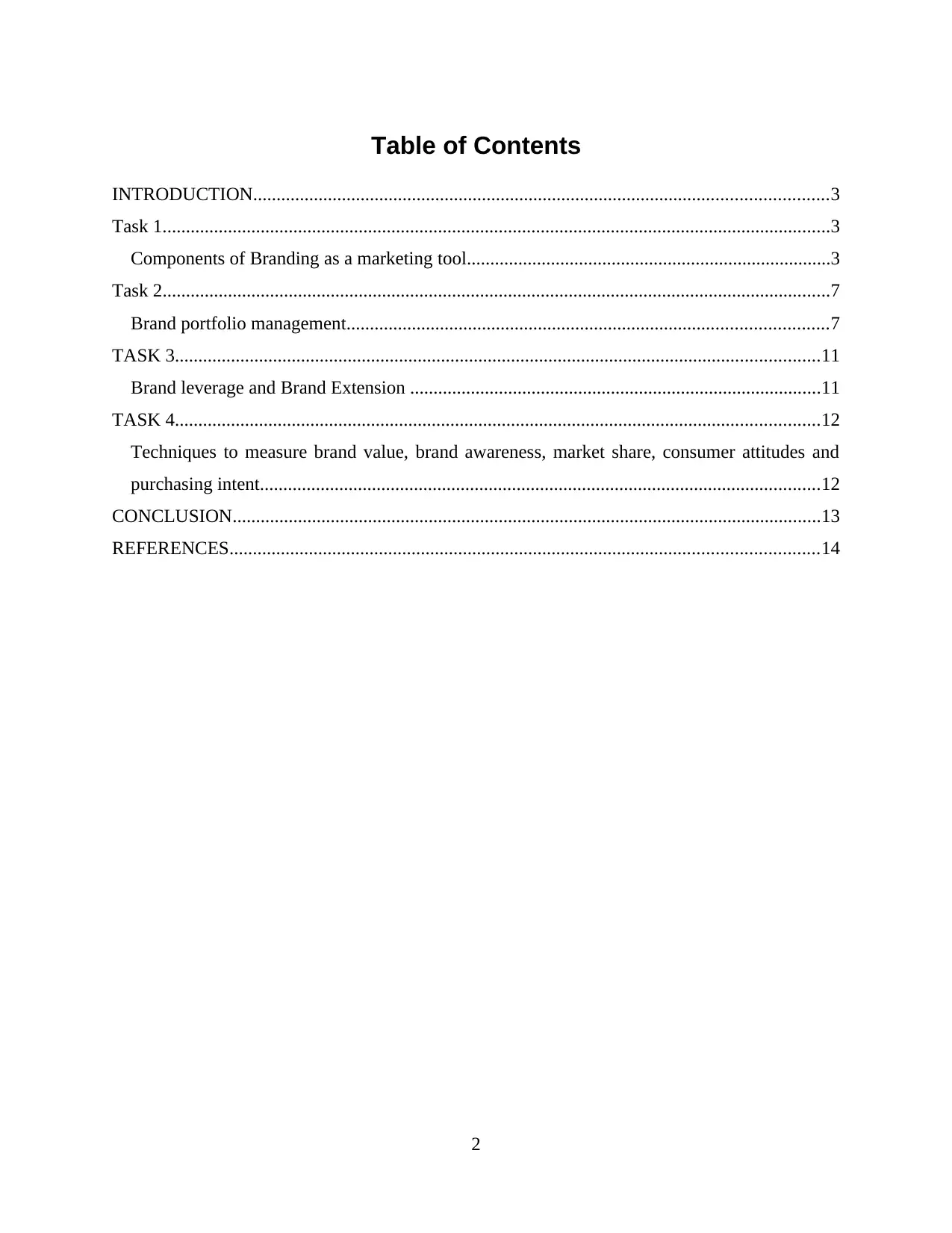
Table of Contents
INTRODUCTION...........................................................................................................................3
Task 1...............................................................................................................................................3
Components of Branding as a marketing tool..............................................................................3
Task 2...............................................................................................................................................7
Brand portfolio management.......................................................................................................7
TASK 3..........................................................................................................................................11
Brand leverage and Brand Extension ........................................................................................11
TASK 4..........................................................................................................................................12
Techniques to measure brand value, brand awareness, market share, consumer attitudes and
purchasing intent........................................................................................................................12
CONCLUSION..............................................................................................................................13
REFERENCES..............................................................................................................................14
2
INTRODUCTION...........................................................................................................................3
Task 1...............................................................................................................................................3
Components of Branding as a marketing tool..............................................................................3
Task 2...............................................................................................................................................7
Brand portfolio management.......................................................................................................7
TASK 3..........................................................................................................................................11
Brand leverage and Brand Extension ........................................................................................11
TASK 4..........................................................................................................................................12
Techniques to measure brand value, brand awareness, market share, consumer attitudes and
purchasing intent........................................................................................................................12
CONCLUSION..............................................................................................................................13
REFERENCES..............................................................................................................................14
2
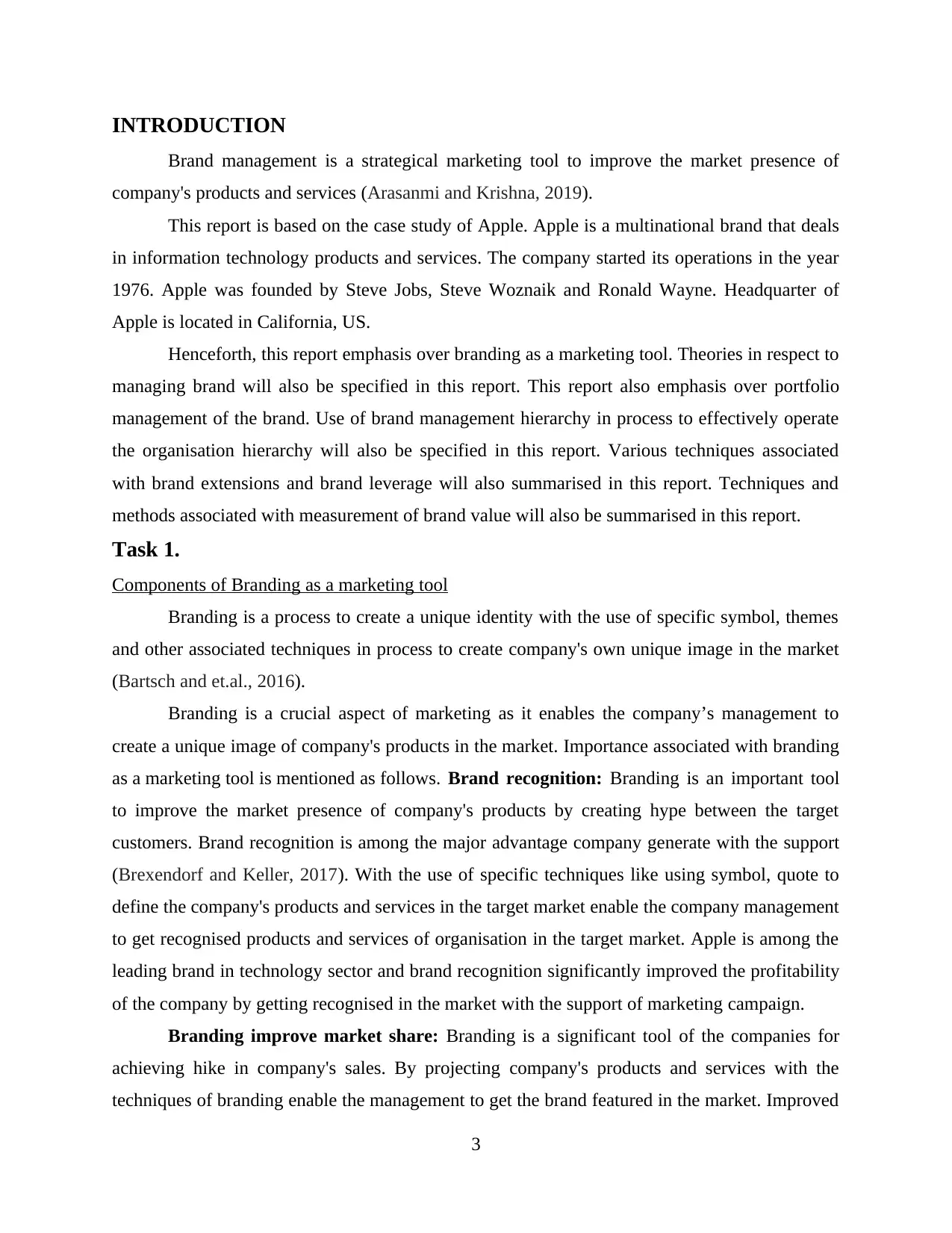
INTRODUCTION
Brand management is a strategical marketing tool to improve the market presence of
company's products and services (Arasanmi and Krishna, 2019).
This report is based on the case study of Apple. Apple is a multinational brand that deals
in information technology products and services. The company started its operations in the year
1976. Apple was founded by Steve Jobs, Steve Woznaik and Ronald Wayne. Headquarter of
Apple is located in California, US.
Henceforth, this report emphasis over branding as a marketing tool. Theories in respect to
managing brand will also be specified in this report. This report also emphasis over portfolio
management of the brand. Use of brand management hierarchy in process to effectively operate
the organisation hierarchy will also be specified in this report. Various techniques associated
with brand extensions and brand leverage will also summarised in this report. Techniques and
methods associated with measurement of brand value will also be summarised in this report.
Task 1.
Components of Branding as a marketing tool
Branding is a process to create a unique identity with the use of specific symbol, themes
and other associated techniques in process to create company's own unique image in the market
(Bartsch and et.al., 2016).
Branding is a crucial aspect of marketing as it enables the company’s management to
create a unique image of company's products in the market. Importance associated with branding
as a marketing tool is mentioned as follows. Brand recognition: Branding is an important tool
to improve the market presence of company's products by creating hype between the target
customers. Brand recognition is among the major advantage company generate with the support
(Brexendorf and Keller, 2017). With the use of specific techniques like using symbol, quote to
define the company's products and services in the target market enable the company management
to get recognised products and services of organisation in the target market. Apple is among the
leading brand in technology sector and brand recognition significantly improved the profitability
of the company by getting recognised in the market with the support of marketing campaign.
Branding improve market share: Branding is a significant tool of the companies for
achieving hike in company's sales. By projecting company's products and services with the
techniques of branding enable the management to get the brand featured in the market. Improved
3
Brand management is a strategical marketing tool to improve the market presence of
company's products and services (Arasanmi and Krishna, 2019).
This report is based on the case study of Apple. Apple is a multinational brand that deals
in information technology products and services. The company started its operations in the year
1976. Apple was founded by Steve Jobs, Steve Woznaik and Ronald Wayne. Headquarter of
Apple is located in California, US.
Henceforth, this report emphasis over branding as a marketing tool. Theories in respect to
managing brand will also be specified in this report. This report also emphasis over portfolio
management of the brand. Use of brand management hierarchy in process to effectively operate
the organisation hierarchy will also be specified in this report. Various techniques associated
with brand extensions and brand leverage will also summarised in this report. Techniques and
methods associated with measurement of brand value will also be summarised in this report.
Task 1.
Components of Branding as a marketing tool
Branding is a process to create a unique identity with the use of specific symbol, themes
and other associated techniques in process to create company's own unique image in the market
(Bartsch and et.al., 2016).
Branding is a crucial aspect of marketing as it enables the company’s management to
create a unique image of company's products in the market. Importance associated with branding
as a marketing tool is mentioned as follows. Brand recognition: Branding is an important tool
to improve the market presence of company's products by creating hype between the target
customers. Brand recognition is among the major advantage company generate with the support
(Brexendorf and Keller, 2017). With the use of specific techniques like using symbol, quote to
define the company's products and services in the target market enable the company management
to get recognised products and services of organisation in the target market. Apple is among the
leading brand in technology sector and brand recognition significantly improved the profitability
of the company by getting recognised in the market with the support of marketing campaign.
Branding improve market share: Branding is a significant tool of the companies for
achieving hike in company's sales. By projecting company's products and services with the
techniques of branding enable the management to get the brand featured in the market. Improved
3
⊘ This is a preview!⊘
Do you want full access?
Subscribe today to unlock all pages.

Trusted by 1+ million students worldwide
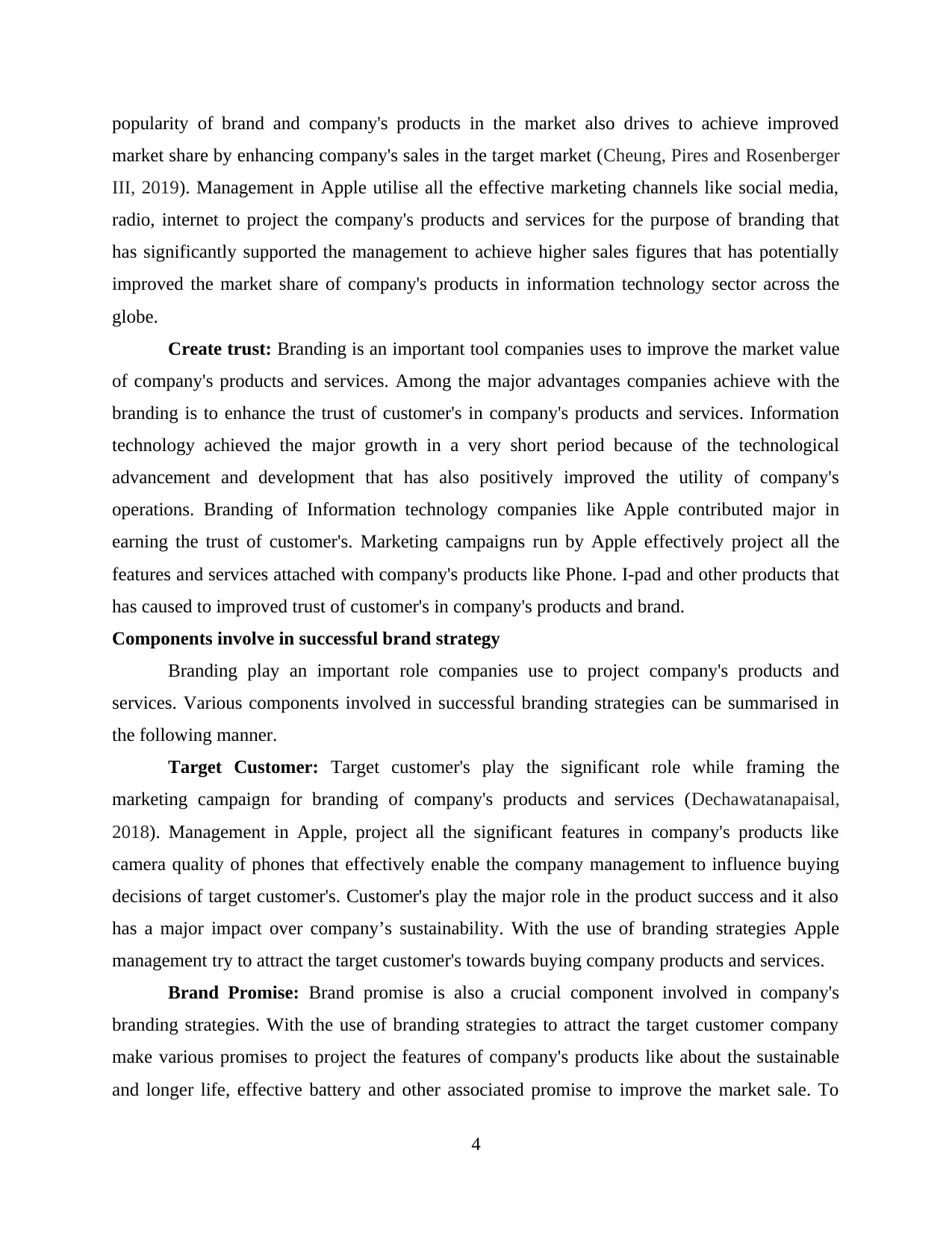
popularity of brand and company's products in the market also drives to achieve improved
market share by enhancing company's sales in the target market (Cheung, Pires and Rosenberger
III, 2019). Management in Apple utilise all the effective marketing channels like social media,
radio, internet to project the company's products and services for the purpose of branding that
has significantly supported the management to achieve higher sales figures that has potentially
improved the market share of company's products in information technology sector across the
globe.
Create trust: Branding is an important tool companies uses to improve the market value
of company's products and services. Among the major advantages companies achieve with the
branding is to enhance the trust of customer's in company's products and services. Information
technology achieved the major growth in a very short period because of the technological
advancement and development that has also positively improved the utility of company's
operations. Branding of Information technology companies like Apple contributed major in
earning the trust of customer's. Marketing campaigns run by Apple effectively project all the
features and services attached with company's products like Phone. I-pad and other products that
has caused to improved trust of customer's in company's products and brand.
Components involve in successful brand strategy
Branding play an important role companies use to project company's products and
services. Various components involved in successful branding strategies can be summarised in
the following manner.
Target Customer: Target customer's play the significant role while framing the
marketing campaign for branding of company's products and services (Dechawatanapaisal,
2018). Management in Apple, project all the significant features in company's products like
camera quality of phones that effectively enable the company management to influence buying
decisions of target customer's. Customer's play the major role in the product success and it also
has a major impact over company’s sustainability. With the use of branding strategies Apple
management try to attract the target customer's towards buying company products and services.
Brand Promise: Brand promise is also a crucial component involved in company's
branding strategies. With the use of branding strategies to attract the target customer company
make various promises to project the features of company's products like about the sustainable
and longer life, effective battery and other associated promise to improve the market sale. To
4
market share by enhancing company's sales in the target market (Cheung, Pires and Rosenberger
III, 2019). Management in Apple utilise all the effective marketing channels like social media,
radio, internet to project the company's products and services for the purpose of branding that
has significantly supported the management to achieve higher sales figures that has potentially
improved the market share of company's products in information technology sector across the
globe.
Create trust: Branding is an important tool companies uses to improve the market value
of company's products and services. Among the major advantages companies achieve with the
branding is to enhance the trust of customer's in company's products and services. Information
technology achieved the major growth in a very short period because of the technological
advancement and development that has also positively improved the utility of company's
operations. Branding of Information technology companies like Apple contributed major in
earning the trust of customer's. Marketing campaigns run by Apple effectively project all the
features and services attached with company's products like Phone. I-pad and other products that
has caused to improved trust of customer's in company's products and brand.
Components involve in successful brand strategy
Branding play an important role companies use to project company's products and
services. Various components involved in successful branding strategies can be summarised in
the following manner.
Target Customer: Target customer's play the significant role while framing the
marketing campaign for branding of company's products and services (Dechawatanapaisal,
2018). Management in Apple, project all the significant features in company's products like
camera quality of phones that effectively enable the company management to influence buying
decisions of target customer's. Customer's play the major role in the product success and it also
has a major impact over company’s sustainability. With the use of branding strategies Apple
management try to attract the target customer's towards buying company products and services.
Brand Promise: Brand promise is also a crucial component involved in company's
branding strategies. With the use of branding strategies to attract the target customer company
make various promises to project the features of company's products like about the sustainable
and longer life, effective battery and other associated promise to improve the market sale. To
4
Paraphrase This Document
Need a fresh take? Get an instant paraphrase of this document with our AI Paraphraser
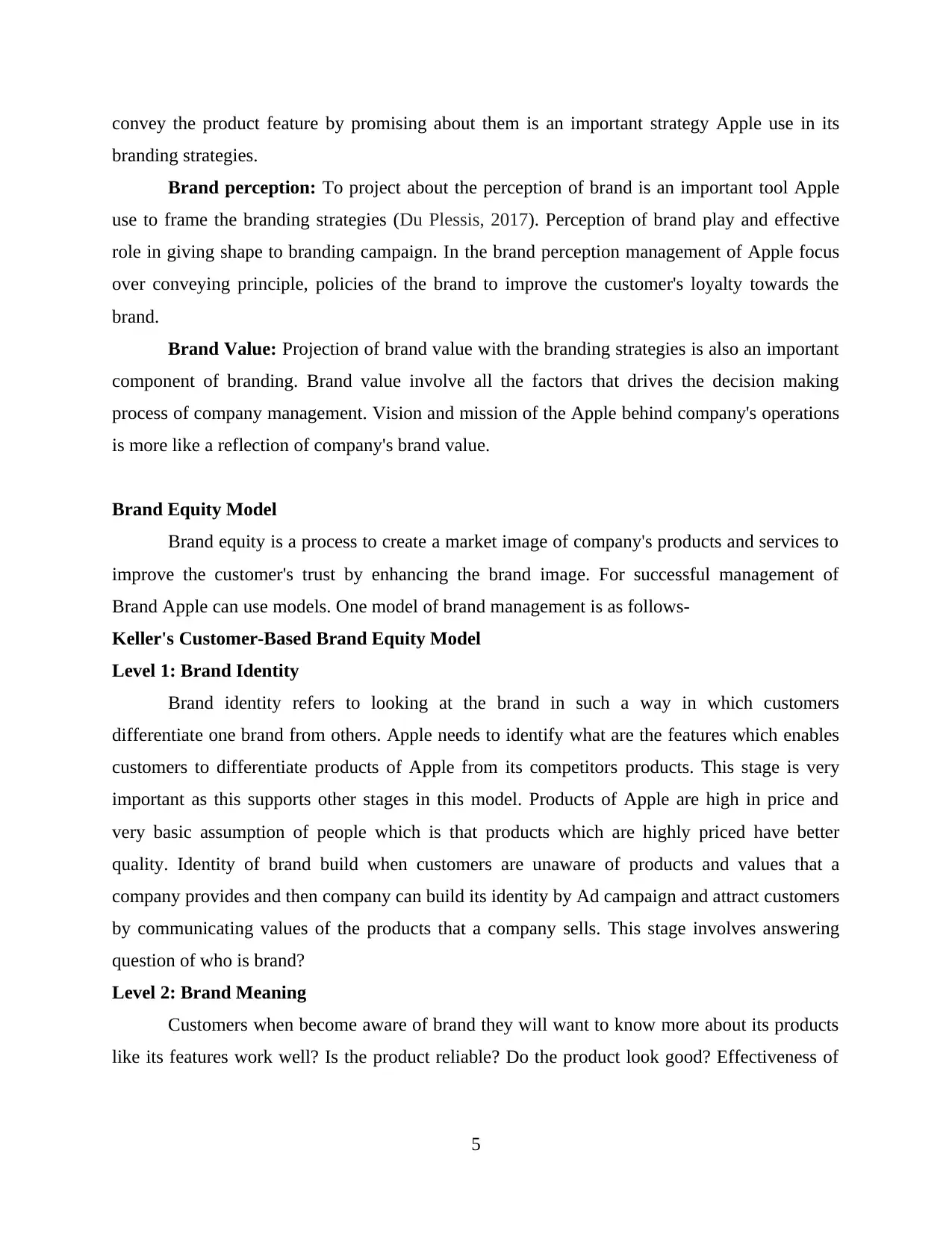
convey the product feature by promising about them is an important strategy Apple use in its
branding strategies.
Brand perception: To project about the perception of brand is an important tool Apple
use to frame the branding strategies (Du Plessis, 2017). Perception of brand play and effective
role in giving shape to branding campaign. In the brand perception management of Apple focus
over conveying principle, policies of the brand to improve the customer's loyalty towards the
brand.
Brand Value: Projection of brand value with the branding strategies is also an important
component of branding. Brand value involve all the factors that drives the decision making
process of company management. Vision and mission of the Apple behind company's operations
is more like a reflection of company's brand value.
Brand Equity Model
Brand equity is a process to create a market image of company's products and services to
improve the customer's trust by enhancing the brand image. For successful management of
Brand Apple can use models. One model of brand management is as follows-
Keller's Customer-Based Brand Equity Model
Level 1: Brand Identity
Brand identity refers to looking at the brand in such a way in which customers
differentiate one brand from others. Apple needs to identify what are the features which enables
customers to differentiate products of Apple from its competitors products. This stage is very
important as this supports other stages in this model. Products of Apple are high in price and
very basic assumption of people which is that products which are highly priced have better
quality. Identity of brand build when customers are unaware of products and values that a
company provides and then company can build its identity by Ad campaign and attract customers
by communicating values of the products that a company sells. This stage involves answering
question of who is brand?
Level 2: Brand Meaning
Customers when become aware of brand they will want to know more about its products
like its features work well? Is the product reliable? Do the product look good? Effectiveness of
5
branding strategies.
Brand perception: To project about the perception of brand is an important tool Apple
use to frame the branding strategies (Du Plessis, 2017). Perception of brand play and effective
role in giving shape to branding campaign. In the brand perception management of Apple focus
over conveying principle, policies of the brand to improve the customer's loyalty towards the
brand.
Brand Value: Projection of brand value with the branding strategies is also an important
component of branding. Brand value involve all the factors that drives the decision making
process of company management. Vision and mission of the Apple behind company's operations
is more like a reflection of company's brand value.
Brand Equity Model
Brand equity is a process to create a market image of company's products and services to
improve the customer's trust by enhancing the brand image. For successful management of
Brand Apple can use models. One model of brand management is as follows-
Keller's Customer-Based Brand Equity Model
Level 1: Brand Identity
Brand identity refers to looking at the brand in such a way in which customers
differentiate one brand from others. Apple needs to identify what are the features which enables
customers to differentiate products of Apple from its competitors products. This stage is very
important as this supports other stages in this model. Products of Apple are high in price and
very basic assumption of people which is that products which are highly priced have better
quality. Identity of brand build when customers are unaware of products and values that a
company provides and then company can build its identity by Ad campaign and attract customers
by communicating values of the products that a company sells. This stage involves answering
question of who is brand?
Level 2: Brand Meaning
Customers when become aware of brand they will want to know more about its products
like its features work well? Is the product reliable? Do the product look good? Effectiveness of
5
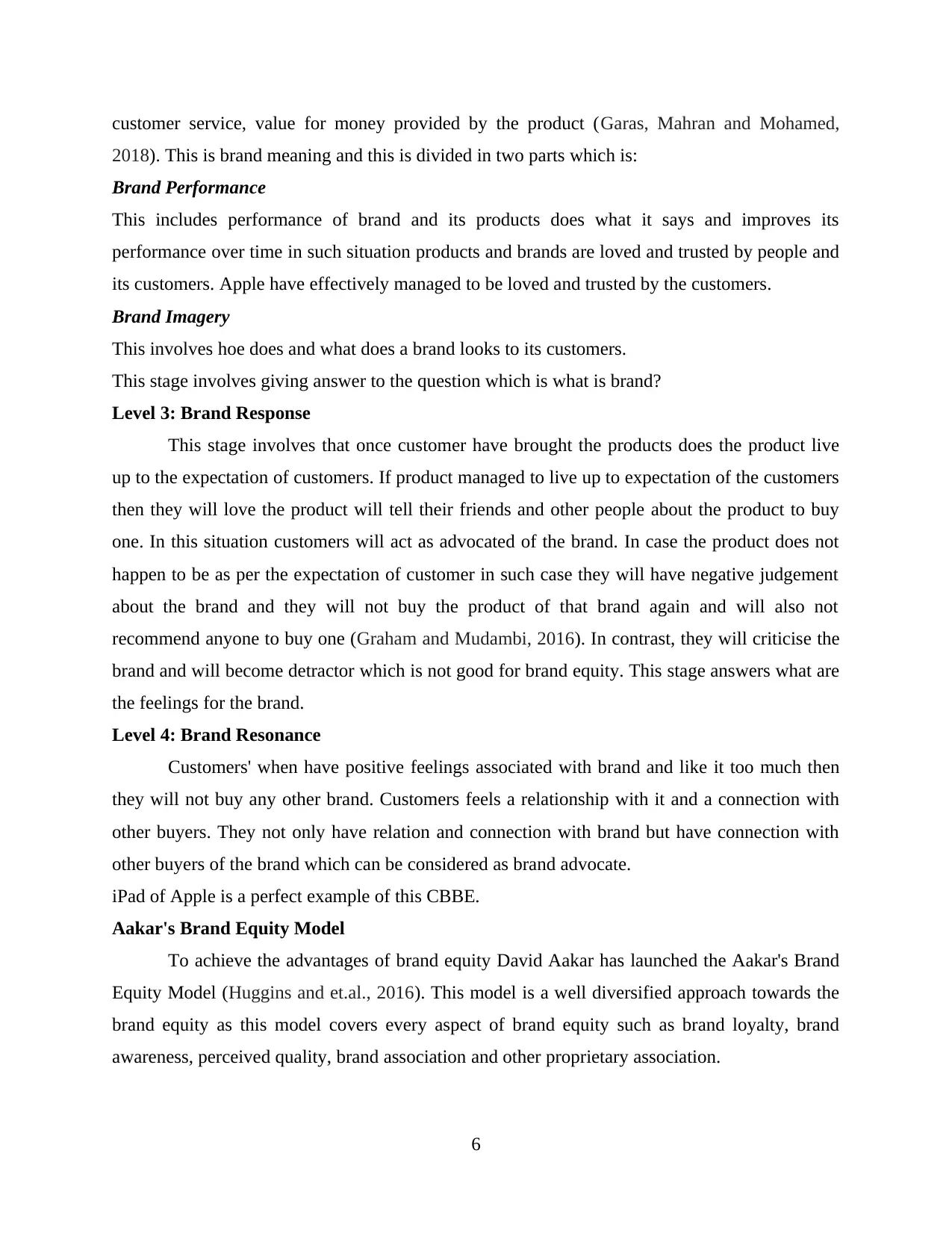
customer service, value for money provided by the product (Garas, Mahran and Mohamed,
2018). This is brand meaning and this is divided in two parts which is:
Brand Performance
This includes performance of brand and its products does what it says and improves its
performance over time in such situation products and brands are loved and trusted by people and
its customers. Apple have effectively managed to be loved and trusted by the customers.
Brand Imagery
This involves hoe does and what does a brand looks to its customers.
This stage involves giving answer to the question which is what is brand?
Level 3: Brand Response
This stage involves that once customer have brought the products does the product live
up to the expectation of customers. If product managed to live up to expectation of the customers
then they will love the product will tell their friends and other people about the product to buy
one. In this situation customers will act as advocated of the brand. In case the product does not
happen to be as per the expectation of customer in such case they will have negative judgement
about the brand and they will not buy the product of that brand again and will also not
recommend anyone to buy one (Graham and Mudambi, 2016). In contrast, they will criticise the
brand and will become detractor which is not good for brand equity. This stage answers what are
the feelings for the brand.
Level 4: Brand Resonance
Customers' when have positive feelings associated with brand and like it too much then
they will not buy any other brand. Customers feels a relationship with it and a connection with
other buyers. They not only have relation and connection with brand but have connection with
other buyers of the brand which can be considered as brand advocate.
iPad of Apple is a perfect example of this CBBE.
Aakar's Brand Equity Model
To achieve the advantages of brand equity David Aakar has launched the Aakar's Brand
Equity Model (Huggins and et.al., 2016). This model is a well diversified approach towards the
brand equity as this model covers every aspect of brand equity such as brand loyalty, brand
awareness, perceived quality, brand association and other proprietary association.
6
2018). This is brand meaning and this is divided in two parts which is:
Brand Performance
This includes performance of brand and its products does what it says and improves its
performance over time in such situation products and brands are loved and trusted by people and
its customers. Apple have effectively managed to be loved and trusted by the customers.
Brand Imagery
This involves hoe does and what does a brand looks to its customers.
This stage involves giving answer to the question which is what is brand?
Level 3: Brand Response
This stage involves that once customer have brought the products does the product live
up to the expectation of customers. If product managed to live up to expectation of the customers
then they will love the product will tell their friends and other people about the product to buy
one. In this situation customers will act as advocated of the brand. In case the product does not
happen to be as per the expectation of customer in such case they will have negative judgement
about the brand and they will not buy the product of that brand again and will also not
recommend anyone to buy one (Graham and Mudambi, 2016). In contrast, they will criticise the
brand and will become detractor which is not good for brand equity. This stage answers what are
the feelings for the brand.
Level 4: Brand Resonance
Customers' when have positive feelings associated with brand and like it too much then
they will not buy any other brand. Customers feels a relationship with it and a connection with
other buyers. They not only have relation and connection with brand but have connection with
other buyers of the brand which can be considered as brand advocate.
iPad of Apple is a perfect example of this CBBE.
Aakar's Brand Equity Model
To achieve the advantages of brand equity David Aakar has launched the Aakar's Brand
Equity Model (Huggins and et.al., 2016). This model is a well diversified approach towards the
brand equity as this model covers every aspect of brand equity such as brand loyalty, brand
awareness, perceived quality, brand association and other proprietary association.
6
⊘ This is a preview!⊘
Do you want full access?
Subscribe today to unlock all pages.

Trusted by 1+ million students worldwide
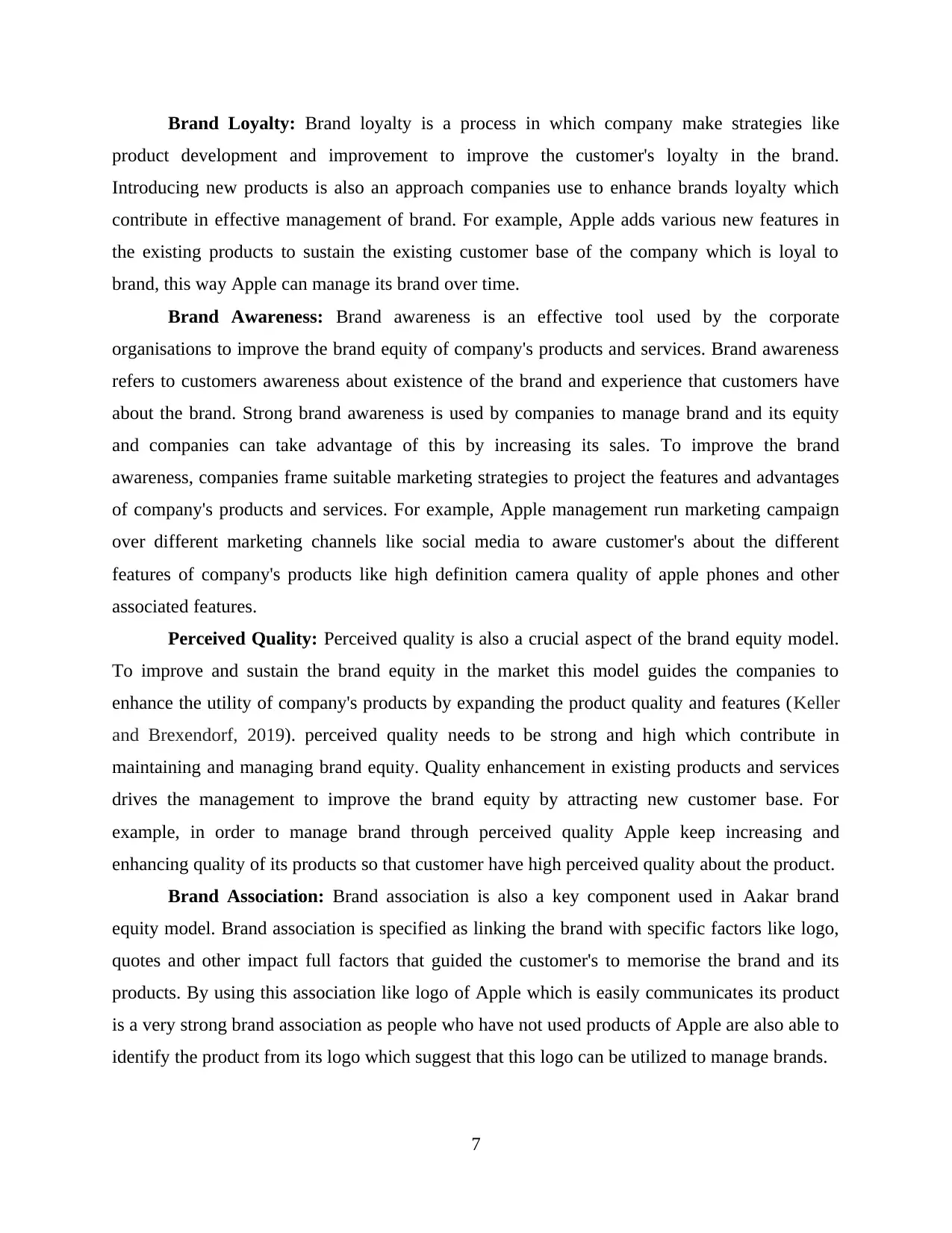
Brand Loyalty: Brand loyalty is a process in which company make strategies like
product development and improvement to improve the customer's loyalty in the brand.
Introducing new products is also an approach companies use to enhance brands loyalty which
contribute in effective management of brand. For example, Apple adds various new features in
the existing products to sustain the existing customer base of the company which is loyal to
brand, this way Apple can manage its brand over time.
Brand Awareness: Brand awareness is an effective tool used by the corporate
organisations to improve the brand equity of company's products and services. Brand awareness
refers to customers awareness about existence of the brand and experience that customers have
about the brand. Strong brand awareness is used by companies to manage brand and its equity
and companies can take advantage of this by increasing its sales. To improve the brand
awareness, companies frame suitable marketing strategies to project the features and advantages
of company's products and services. For example, Apple management run marketing campaign
over different marketing channels like social media to aware customer's about the different
features of company's products like high definition camera quality of apple phones and other
associated features.
Perceived Quality: Perceived quality is also a crucial aspect of the brand equity model.
To improve and sustain the brand equity in the market this model guides the companies to
enhance the utility of company's products by expanding the product quality and features (Keller
and Brexendorf, 2019). perceived quality needs to be strong and high which contribute in
maintaining and managing brand equity. Quality enhancement in existing products and services
drives the management to improve the brand equity by attracting new customer base. For
example, in order to manage brand through perceived quality Apple keep increasing and
enhancing quality of its products so that customer have high perceived quality about the product.
Brand Association: Brand association is also a key component used in Aakar brand
equity model. Brand association is specified as linking the brand with specific factors like logo,
quotes and other impact full factors that guided the customer's to memorise the brand and its
products. By using this association like logo of Apple which is easily communicates its product
is a very strong brand association as people who have not used products of Apple are also able to
identify the product from its logo which suggest that this logo can be utilized to manage brands.
7
product development and improvement to improve the customer's loyalty in the brand.
Introducing new products is also an approach companies use to enhance brands loyalty which
contribute in effective management of brand. For example, Apple adds various new features in
the existing products to sustain the existing customer base of the company which is loyal to
brand, this way Apple can manage its brand over time.
Brand Awareness: Brand awareness is an effective tool used by the corporate
organisations to improve the brand equity of company's products and services. Brand awareness
refers to customers awareness about existence of the brand and experience that customers have
about the brand. Strong brand awareness is used by companies to manage brand and its equity
and companies can take advantage of this by increasing its sales. To improve the brand
awareness, companies frame suitable marketing strategies to project the features and advantages
of company's products and services. For example, Apple management run marketing campaign
over different marketing channels like social media to aware customer's about the different
features of company's products like high definition camera quality of apple phones and other
associated features.
Perceived Quality: Perceived quality is also a crucial aspect of the brand equity model.
To improve and sustain the brand equity in the market this model guides the companies to
enhance the utility of company's products by expanding the product quality and features (Keller
and Brexendorf, 2019). perceived quality needs to be strong and high which contribute in
maintaining and managing brand equity. Quality enhancement in existing products and services
drives the management to improve the brand equity by attracting new customer base. For
example, in order to manage brand through perceived quality Apple keep increasing and
enhancing quality of its products so that customer have high perceived quality about the product.
Brand Association: Brand association is also a key component used in Aakar brand
equity model. Brand association is specified as linking the brand with specific factors like logo,
quotes and other impact full factors that guided the customer's to memorise the brand and its
products. By using this association like logo of Apple which is easily communicates its product
is a very strong brand association as people who have not used products of Apple are also able to
identify the product from its logo which suggest that this logo can be utilized to manage brands.
7
Paraphrase This Document
Need a fresh take? Get an instant paraphrase of this document with our AI Paraphraser
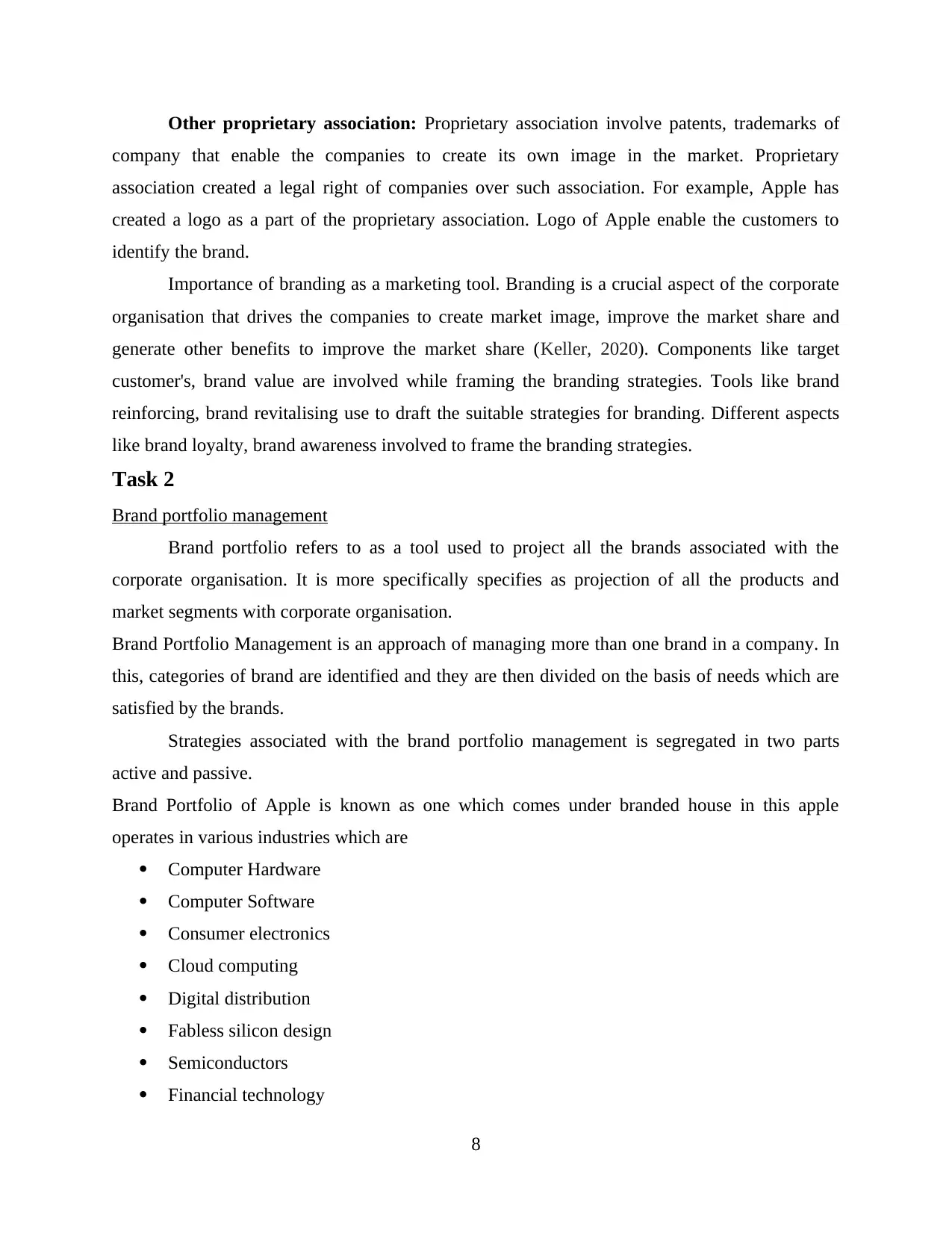
Other proprietary association: Proprietary association involve patents, trademarks of
company that enable the companies to create its own image in the market. Proprietary
association created a legal right of companies over such association. For example, Apple has
created a logo as a part of the proprietary association. Logo of Apple enable the customers to
identify the brand.
Importance of branding as a marketing tool. Branding is a crucial aspect of the corporate
organisation that drives the companies to create market image, improve the market share and
generate other benefits to improve the market share (Keller, 2020). Components like target
customer's, brand value are involved while framing the branding strategies. Tools like brand
reinforcing, brand revitalising use to draft the suitable strategies for branding. Different aspects
like brand loyalty, brand awareness involved to frame the branding strategies.
Task 2
Brand portfolio management
Brand portfolio refers to as a tool used to project all the brands associated with the
corporate organisation. It is more specifically specifies as projection of all the products and
market segments with corporate organisation.
Brand Portfolio Management is an approach of managing more than one brand in a company. In
this, categories of brand are identified and they are then divided on the basis of needs which are
satisfied by the brands.
Strategies associated with the brand portfolio management is segregated in two parts
active and passive.
Brand Portfolio of Apple is known as one which comes under branded house in this apple
operates in various industries which are
Computer Hardware
Computer Software
Consumer electronics
Cloud computing
Digital distribution
Fabless silicon design
Semiconductors
Financial technology
8
company that enable the companies to create its own image in the market. Proprietary
association created a legal right of companies over such association. For example, Apple has
created a logo as a part of the proprietary association. Logo of Apple enable the customers to
identify the brand.
Importance of branding as a marketing tool. Branding is a crucial aspect of the corporate
organisation that drives the companies to create market image, improve the market share and
generate other benefits to improve the market share (Keller, 2020). Components like target
customer's, brand value are involved while framing the branding strategies. Tools like brand
reinforcing, brand revitalising use to draft the suitable strategies for branding. Different aspects
like brand loyalty, brand awareness involved to frame the branding strategies.
Task 2
Brand portfolio management
Brand portfolio refers to as a tool used to project all the brands associated with the
corporate organisation. It is more specifically specifies as projection of all the products and
market segments with corporate organisation.
Brand Portfolio Management is an approach of managing more than one brand in a company. In
this, categories of brand are identified and they are then divided on the basis of needs which are
satisfied by the brands.
Strategies associated with the brand portfolio management is segregated in two parts
active and passive.
Brand Portfolio of Apple is known as one which comes under branded house in this apple
operates in various industries which are
Computer Hardware
Computer Software
Consumer electronics
Cloud computing
Digital distribution
Fabless silicon design
Semiconductors
Financial technology
8
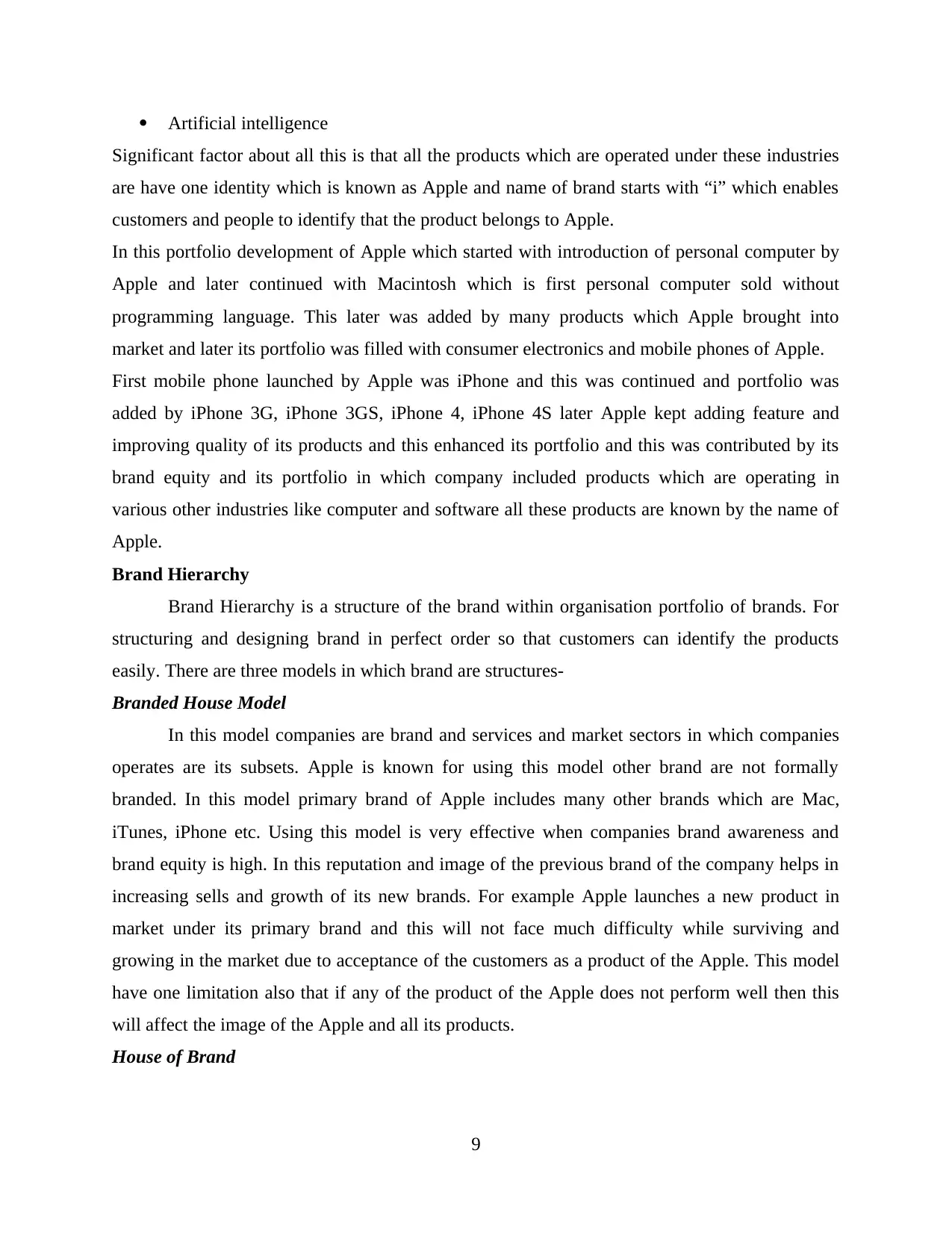
Artificial intelligence
Significant factor about all this is that all the products which are operated under these industries
are have one identity which is known as Apple and name of brand starts with “i” which enables
customers and people to identify that the product belongs to Apple.
In this portfolio development of Apple which started with introduction of personal computer by
Apple and later continued with Macintosh which is first personal computer sold without
programming language. This later was added by many products which Apple brought into
market and later its portfolio was filled with consumer electronics and mobile phones of Apple.
First mobile phone launched by Apple was iPhone and this was continued and portfolio was
added by iPhone 3G, iPhone 3GS, iPhone 4, iPhone 4S later Apple kept adding feature and
improving quality of its products and this enhanced its portfolio and this was contributed by its
brand equity and its portfolio in which company included products which are operating in
various other industries like computer and software all these products are known by the name of
Apple.
Brand Hierarchy
Brand Hierarchy is a structure of the brand within organisation portfolio of brands. For
structuring and designing brand in perfect order so that customers can identify the products
easily. There are three models in which brand are structures-
Branded House Model
In this model companies are brand and services and market sectors in which companies
operates are its subsets. Apple is known for using this model other brand are not formally
branded. In this model primary brand of Apple includes many other brands which are Mac,
iTunes, iPhone etc. Using this model is very effective when companies brand awareness and
brand equity is high. In this reputation and image of the previous brand of the company helps in
increasing sells and growth of its new brands. For example Apple launches a new product in
market under its primary brand and this will not face much difficulty while surviving and
growing in the market due to acceptance of the customers as a product of the Apple. This model
have one limitation also that if any of the product of the Apple does not perform well then this
will affect the image of the Apple and all its products.
House of Brand
9
Significant factor about all this is that all the products which are operated under these industries
are have one identity which is known as Apple and name of brand starts with “i” which enables
customers and people to identify that the product belongs to Apple.
In this portfolio development of Apple which started with introduction of personal computer by
Apple and later continued with Macintosh which is first personal computer sold without
programming language. This later was added by many products which Apple brought into
market and later its portfolio was filled with consumer electronics and mobile phones of Apple.
First mobile phone launched by Apple was iPhone and this was continued and portfolio was
added by iPhone 3G, iPhone 3GS, iPhone 4, iPhone 4S later Apple kept adding feature and
improving quality of its products and this enhanced its portfolio and this was contributed by its
brand equity and its portfolio in which company included products which are operating in
various other industries like computer and software all these products are known by the name of
Apple.
Brand Hierarchy
Brand Hierarchy is a structure of the brand within organisation portfolio of brands. For
structuring and designing brand in perfect order so that customers can identify the products
easily. There are three models in which brand are structures-
Branded House Model
In this model companies are brand and services and market sectors in which companies
operates are its subsets. Apple is known for using this model other brand are not formally
branded. In this model primary brand of Apple includes many other brands which are Mac,
iTunes, iPhone etc. Using this model is very effective when companies brand awareness and
brand equity is high. In this reputation and image of the previous brand of the company helps in
increasing sells and growth of its new brands. For example Apple launches a new product in
market under its primary brand and this will not face much difficulty while surviving and
growing in the market due to acceptance of the customers as a product of the Apple. This model
have one limitation also that if any of the product of the Apple does not perform well then this
will affect the image of the Apple and all its products.
House of Brand
9
⊘ This is a preview!⊘
Do you want full access?
Subscribe today to unlock all pages.

Trusted by 1+ million students worldwide
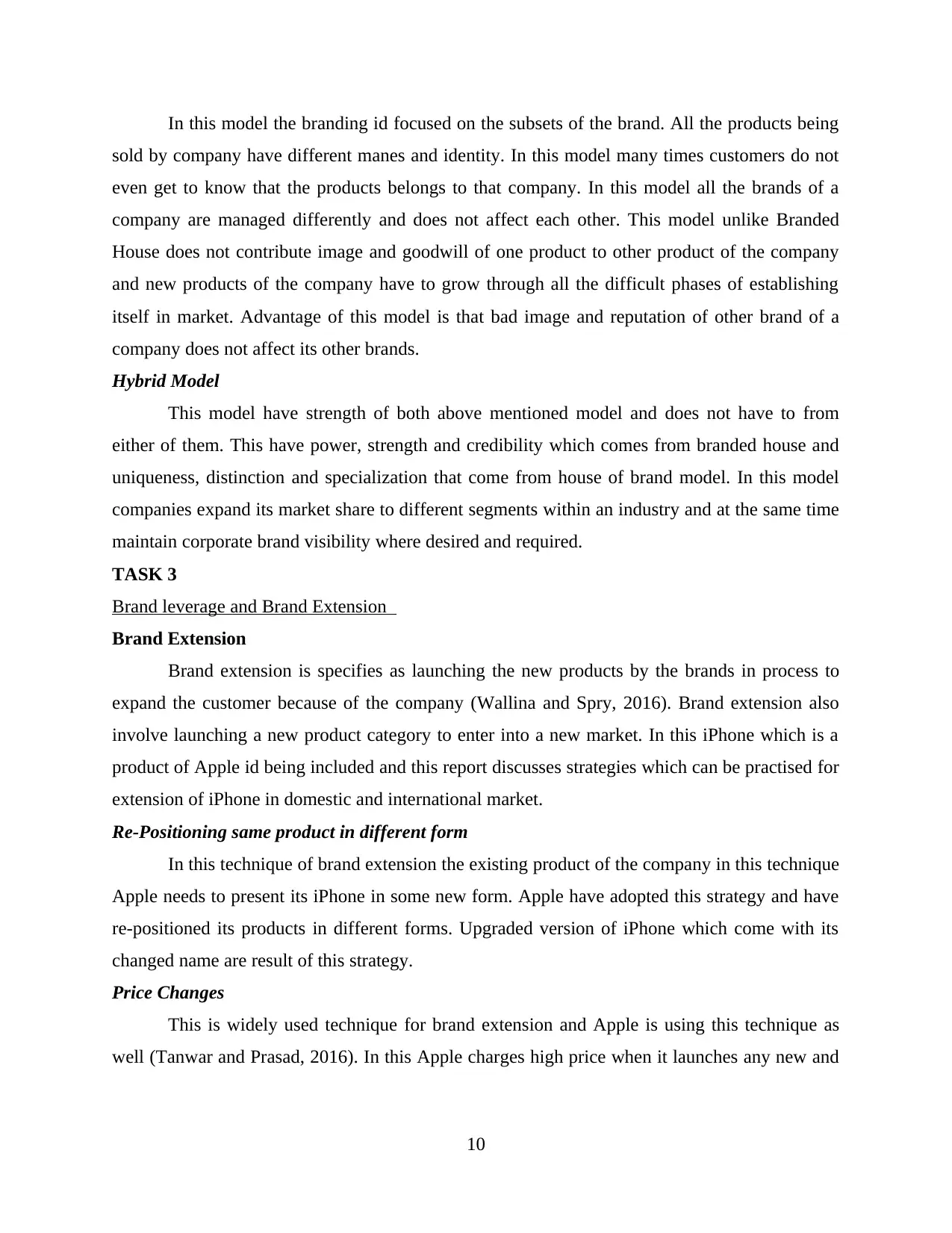
In this model the branding id focused on the subsets of the brand. All the products being
sold by company have different manes and identity. In this model many times customers do not
even get to know that the products belongs to that company. In this model all the brands of a
company are managed differently and does not affect each other. This model unlike Branded
House does not contribute image and goodwill of one product to other product of the company
and new products of the company have to grow through all the difficult phases of establishing
itself in market. Advantage of this model is that bad image and reputation of other brand of a
company does not affect its other brands.
Hybrid Model
This model have strength of both above mentioned model and does not have to from
either of them. This have power, strength and credibility which comes from branded house and
uniqueness, distinction and specialization that come from house of brand model. In this model
companies expand its market share to different segments within an industry and at the same time
maintain corporate brand visibility where desired and required.
TASK 3
Brand leverage and Brand Extension
Brand Extension
Brand extension is specifies as launching the new products by the brands in process to
expand the customer because of the company (Wallina and Spry, 2016). Brand extension also
involve launching a new product category to enter into a new market. In this iPhone which is a
product of Apple id being included and this report discusses strategies which can be practised for
extension of iPhone in domestic and international market.
Re-Positioning same product in different form
In this technique of brand extension the existing product of the company in this technique
Apple needs to present its iPhone in some new form. Apple have adopted this strategy and have
re-positioned its products in different forms. Upgraded version of iPhone which come with its
changed name are result of this strategy.
Price Changes
This is widely used technique for brand extension and Apple is using this technique as
well (Tanwar and Prasad, 2016). In this Apple charges high price when it launches any new and
10
sold by company have different manes and identity. In this model many times customers do not
even get to know that the products belongs to that company. In this model all the brands of a
company are managed differently and does not affect each other. This model unlike Branded
House does not contribute image and goodwill of one product to other product of the company
and new products of the company have to grow through all the difficult phases of establishing
itself in market. Advantage of this model is that bad image and reputation of other brand of a
company does not affect its other brands.
Hybrid Model
This model have strength of both above mentioned model and does not have to from
either of them. This have power, strength and credibility which comes from branded house and
uniqueness, distinction and specialization that come from house of brand model. In this model
companies expand its market share to different segments within an industry and at the same time
maintain corporate brand visibility where desired and required.
TASK 3
Brand leverage and Brand Extension
Brand Extension
Brand extension is specifies as launching the new products by the brands in process to
expand the customer because of the company (Wallina and Spry, 2016). Brand extension also
involve launching a new product category to enter into a new market. In this iPhone which is a
product of Apple id being included and this report discusses strategies which can be practised for
extension of iPhone in domestic and international market.
Re-Positioning same product in different form
In this technique of brand extension the existing product of the company in this technique
Apple needs to present its iPhone in some new form. Apple have adopted this strategy and have
re-positioned its products in different forms. Upgraded version of iPhone which come with its
changed name are result of this strategy.
Price Changes
This is widely used technique for brand extension and Apple is using this technique as
well (Tanwar and Prasad, 2016). In this Apple charges high price when it launches any new and
10
Paraphrase This Document
Need a fresh take? Get an instant paraphrase of this document with our AI Paraphraser
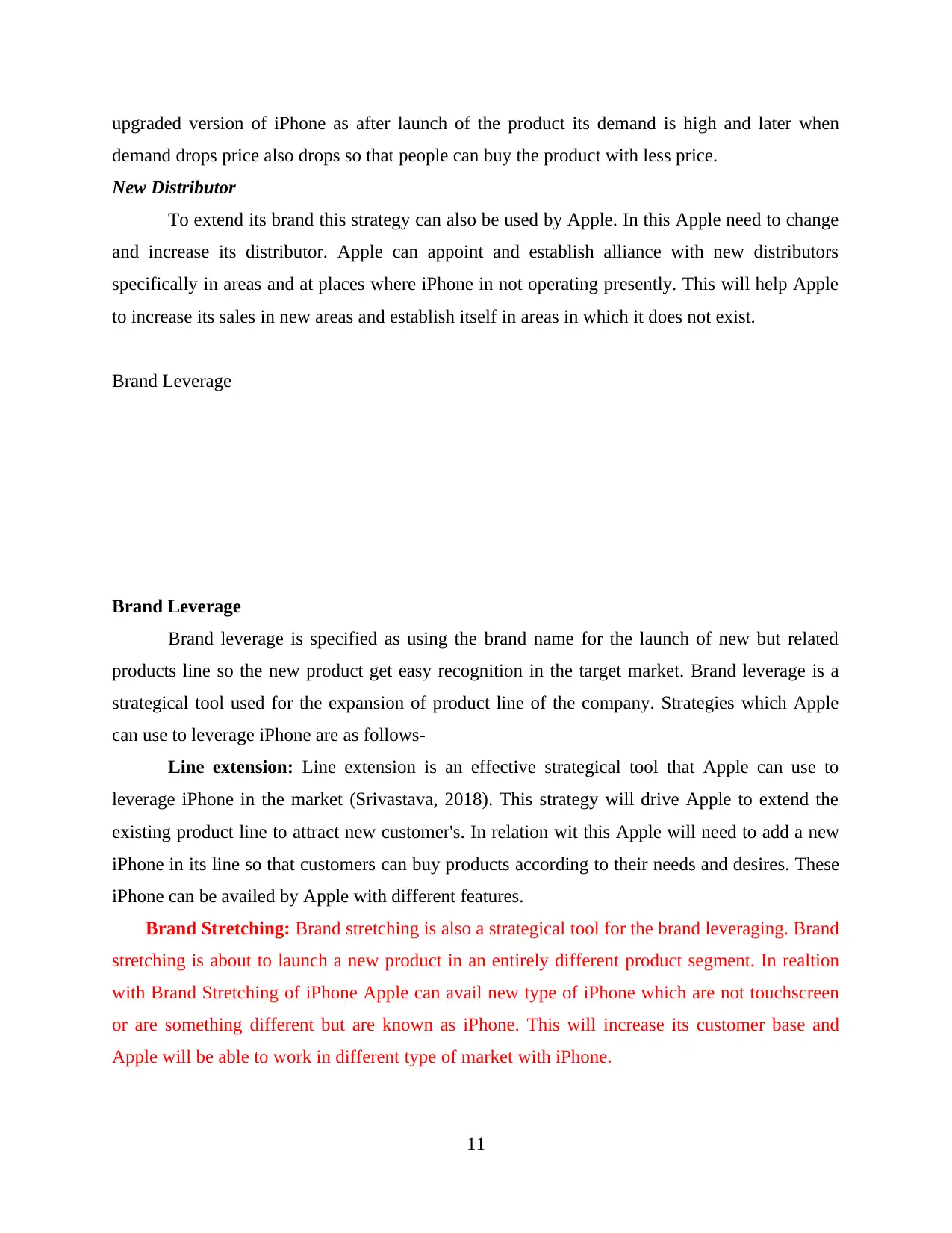
upgraded version of iPhone as after launch of the product its demand is high and later when
demand drops price also drops so that people can buy the product with less price.
New Distributor
To extend its brand this strategy can also be used by Apple. In this Apple need to change
and increase its distributor. Apple can appoint and establish alliance with new distributors
specifically in areas and at places where iPhone in not operating presently. This will help Apple
to increase its sales in new areas and establish itself in areas in which it does not exist.
Brand Leverage
Brand Leverage
Brand leverage is specified as using the brand name for the launch of new but related
products line so the new product get easy recognition in the target market. Brand leverage is a
strategical tool used for the expansion of product line of the company. Strategies which Apple
can use to leverage iPhone are as follows-
Line extension: Line extension is an effective strategical tool that Apple can use to
leverage iPhone in the market (Srivastava, 2018). This strategy will drive Apple to extend the
existing product line to attract new customer's. In relation wit this Apple will need to add a new
iPhone in its line so that customers can buy products according to their needs and desires. These
iPhone can be availed by Apple with different features.
Brand Stretching: Brand stretching is also a strategical tool for the brand leveraging. Brand
stretching is about to launch a new product in an entirely different product segment. In realtion
with Brand Stretching of iPhone Apple can avail new type of iPhone which are not touchscreen
or are something different but are known as iPhone. This will increase its customer base and
Apple will be able to work in different type of market with iPhone.
11
demand drops price also drops so that people can buy the product with less price.
New Distributor
To extend its brand this strategy can also be used by Apple. In this Apple need to change
and increase its distributor. Apple can appoint and establish alliance with new distributors
specifically in areas and at places where iPhone in not operating presently. This will help Apple
to increase its sales in new areas and establish itself in areas in which it does not exist.
Brand Leverage
Brand Leverage
Brand leverage is specified as using the brand name for the launch of new but related
products line so the new product get easy recognition in the target market. Brand leverage is a
strategical tool used for the expansion of product line of the company. Strategies which Apple
can use to leverage iPhone are as follows-
Line extension: Line extension is an effective strategical tool that Apple can use to
leverage iPhone in the market (Srivastava, 2018). This strategy will drive Apple to extend the
existing product line to attract new customer's. In relation wit this Apple will need to add a new
iPhone in its line so that customers can buy products according to their needs and desires. These
iPhone can be availed by Apple with different features.
Brand Stretching: Brand stretching is also a strategical tool for the brand leveraging. Brand
stretching is about to launch a new product in an entirely different product segment. In realtion
with Brand Stretching of iPhone Apple can avail new type of iPhone which are not touchscreen
or are something different but are known as iPhone. This will increase its customer base and
Apple will be able to work in different type of market with iPhone.
11
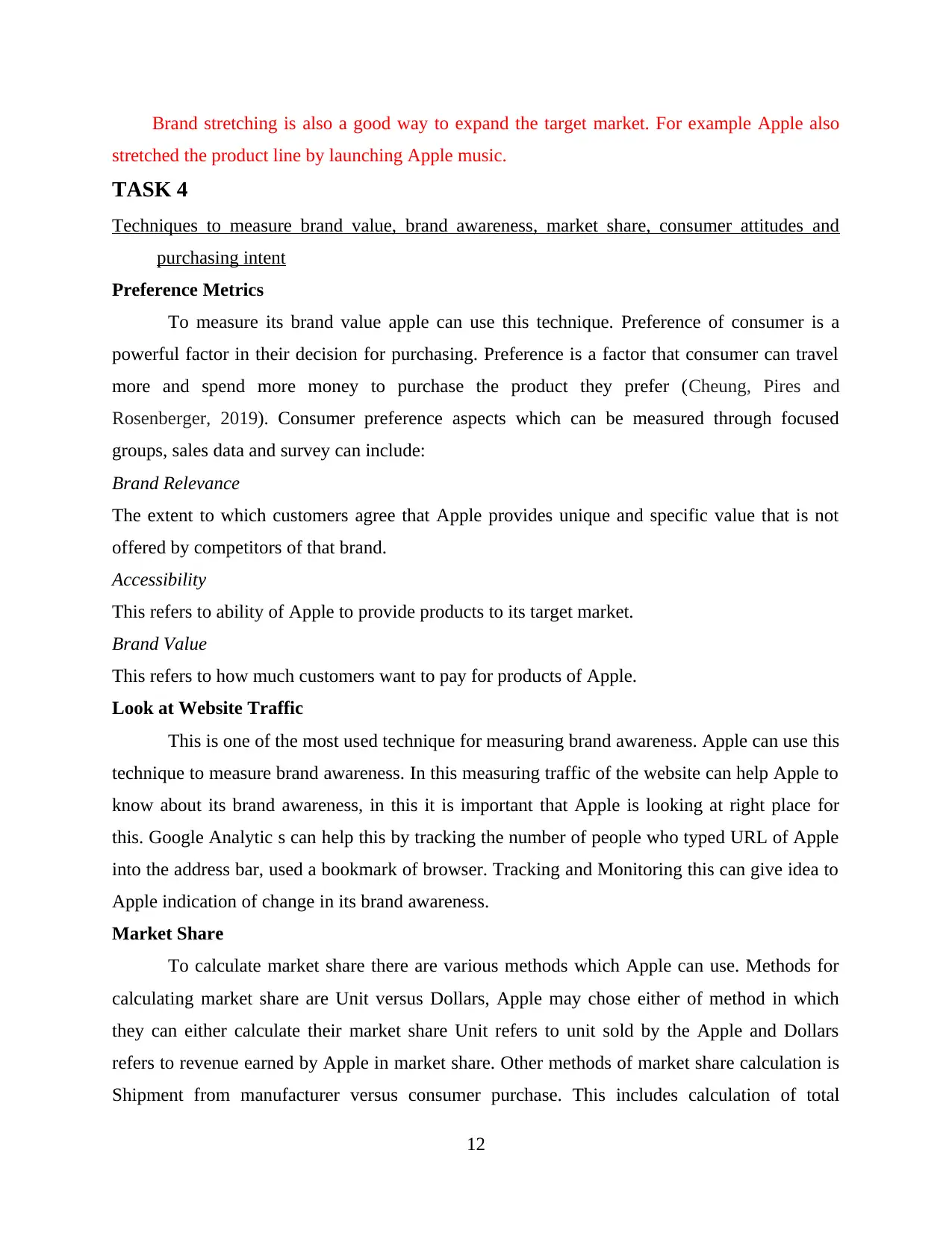
Brand stretching is also a good way to expand the target market. For example Apple also
stretched the product line by launching Apple music.
TASK 4
Techniques to measure brand value, brand awareness, market share, consumer attitudes and
purchasing intent
Preference Metrics
To measure its brand value apple can use this technique. Preference of consumer is a
powerful factor in their decision for purchasing. Preference is a factor that consumer can travel
more and spend more money to purchase the product they prefer (Cheung, Pires and
Rosenberger, 2019). Consumer preference aspects which can be measured through focused
groups, sales data and survey can include:
Brand Relevance
The extent to which customers agree that Apple provides unique and specific value that is not
offered by competitors of that brand.
Accessibility
This refers to ability of Apple to provide products to its target market.
Brand Value
This refers to how much customers want to pay for products of Apple.
Look at Website Traffic
This is one of the most used technique for measuring brand awareness. Apple can use this
technique to measure brand awareness. In this measuring traffic of the website can help Apple to
know about its brand awareness, in this it is important that Apple is looking at right place for
this. Google Analytic s can help this by tracking the number of people who typed URL of Apple
into the address bar, used a bookmark of browser. Tracking and Monitoring this can give idea to
Apple indication of change in its brand awareness.
Market Share
To calculate market share there are various methods which Apple can use. Methods for
calculating market share are Unit versus Dollars, Apple may chose either of method in which
they can either calculate their market share Unit refers to unit sold by the Apple and Dollars
refers to revenue earned by Apple in market share. Other methods of market share calculation is
Shipment from manufacturer versus consumer purchase. This includes calculation of total
12
stretched the product line by launching Apple music.
TASK 4
Techniques to measure brand value, brand awareness, market share, consumer attitudes and
purchasing intent
Preference Metrics
To measure its brand value apple can use this technique. Preference of consumer is a
powerful factor in their decision for purchasing. Preference is a factor that consumer can travel
more and spend more money to purchase the product they prefer (Cheung, Pires and
Rosenberger, 2019). Consumer preference aspects which can be measured through focused
groups, sales data and survey can include:
Brand Relevance
The extent to which customers agree that Apple provides unique and specific value that is not
offered by competitors of that brand.
Accessibility
This refers to ability of Apple to provide products to its target market.
Brand Value
This refers to how much customers want to pay for products of Apple.
Look at Website Traffic
This is one of the most used technique for measuring brand awareness. Apple can use this
technique to measure brand awareness. In this measuring traffic of the website can help Apple to
know about its brand awareness, in this it is important that Apple is looking at right place for
this. Google Analytic s can help this by tracking the number of people who typed URL of Apple
into the address bar, used a bookmark of browser. Tracking and Monitoring this can give idea to
Apple indication of change in its brand awareness.
Market Share
To calculate market share there are various methods which Apple can use. Methods for
calculating market share are Unit versus Dollars, Apple may chose either of method in which
they can either calculate their market share Unit refers to unit sold by the Apple and Dollars
refers to revenue earned by Apple in market share. Other methods of market share calculation is
Shipment from manufacturer versus consumer purchase. This includes calculation of total
12
⊘ This is a preview!⊘
Do you want full access?
Subscribe today to unlock all pages.

Trusted by 1+ million students worldwide
1 out of 16
Related Documents
Your All-in-One AI-Powered Toolkit for Academic Success.
+13062052269
info@desklib.com
Available 24*7 on WhatsApp / Email
![[object Object]](/_next/static/media/star-bottom.7253800d.svg)
Unlock your academic potential
Copyright © 2020–2025 A2Z Services. All Rights Reserved. Developed and managed by ZUCOL.





